

In grammar, transition words play a very important role. If used correctly, they can link your ideas, make your paragraphs more coherent, and enhance your writing.
But first – what exactly are transition words and how should you use them?
Simply put, transition words are words that basically act as the powerful link that holds your sentences together. They are used to show the relationship between two (or more) phrases, sentences, and even paragraphs.
Transition words improve the flow of your writing, and make it more sensible and easier to read. Words like “and,” “additionally,” “because,” “therefore,” etc. are all transition words. Along with transition words, we also have transition phrases like “as well as,” “for example,” “after all,” etc.
Using transition words helps you connect your ideas and thoughts clearly. It helps the reader understand how different ideas logically are related and not get confused. In addition, these words also prepare the readers for what they should expect next.
Let’s consider the following example:
Now, using the transition word “therefore” helped you achieve two things here:
From the above example, the reader will understand that Shannon requires two cups of coffee because she couldn’t sleep well last night. These are two different sentences, but they are glued together with the transition word. Remove the transition word and both of these sentences will lose coherency.
Organized thoughts are essential elements of clear and concise writing. Writers should ensure that all the points mentioned in a sentence have a logical flow and there should not be any abrupt pauses between them.
Transition words help in introducing sequence or order to your writing. Here’s how:
Here, we have used two transition words (“first” and “then”) at the beginning of two different sentences. They are used to denote a particular order in which two actions are to be performed.
High-quality writing is always clear and easy to understand. It has a logical structure and helps the reader move from one thought to another effortlessly. The simpler the writing, the better the readability!
Transition words are the magic connectors that help you write in clear and plain English.
In both the above-mentioned examples, we have used the transition word at the beginning of the sentences. However, these words can also be used in the middle or at the end of a sense or phrase.
Consider the following sentence, for example:
Here, the transition word “because” helps in joining two clauses. It helps the reader understand two things clearly:
Depending upon their usage and the types of transition a writer wishes to make, transition words are usually divided into multiple categories. There are transition words to show contrast, similarity, examples, and whatnot!
Generally, we have more than one transition word for a particular situation/ transition and so writers can pick the ones according to their liking.
Most of the time, these words mean the same things. However, sometimes they have slightly different meanings. Thus, it is important to understand the meaning and use-case of these words before making your final choice.
Here are some transition word examples according to different categories:
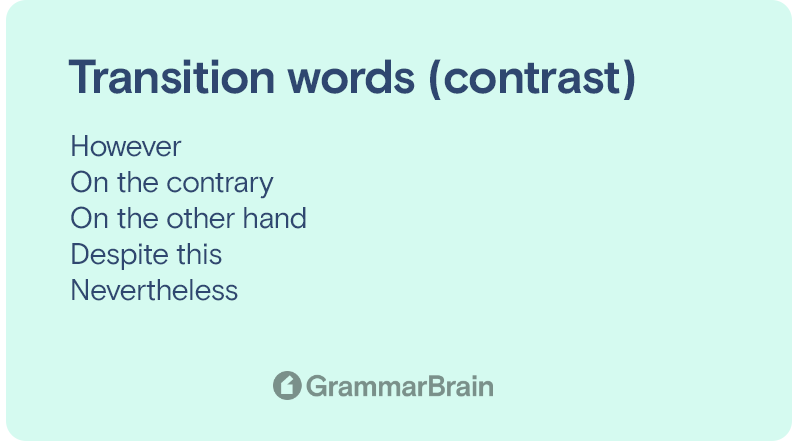
When it comes to displaying contrast “but” is the most common transition word. However, it is not the only word. There are several other transition words that you can use to display contrast in your sentences. Some of the common words include:

The following transition words should be used for showing examples:
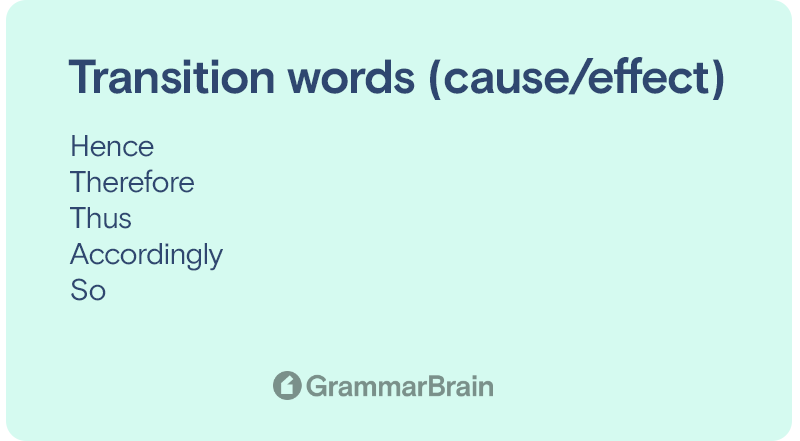
These transition words are used for denoting the cause-and-effect relationship between two sentences. The common transition words you can use for this are as follows:
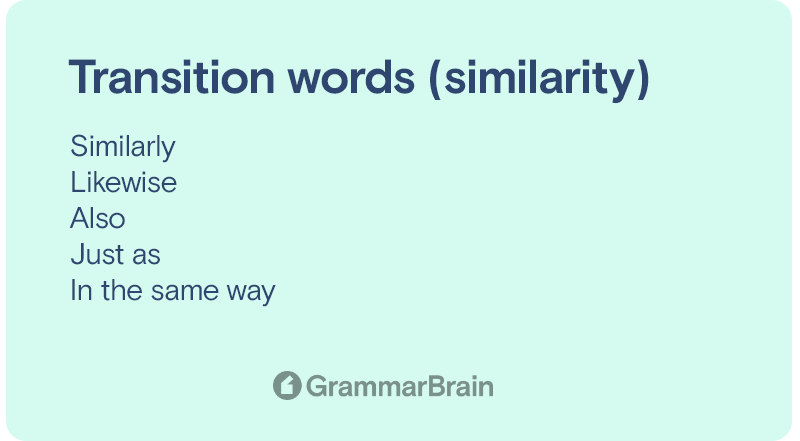
Another common use of transition words is to show the similarity between sentences and phrases. Here are some commonly used transition words for denoting the similarity between two sentences:
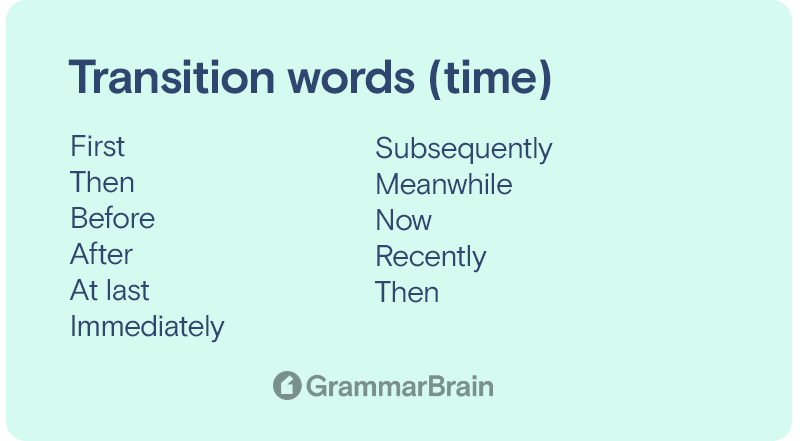
For showing different periods, the following transition words should be used:
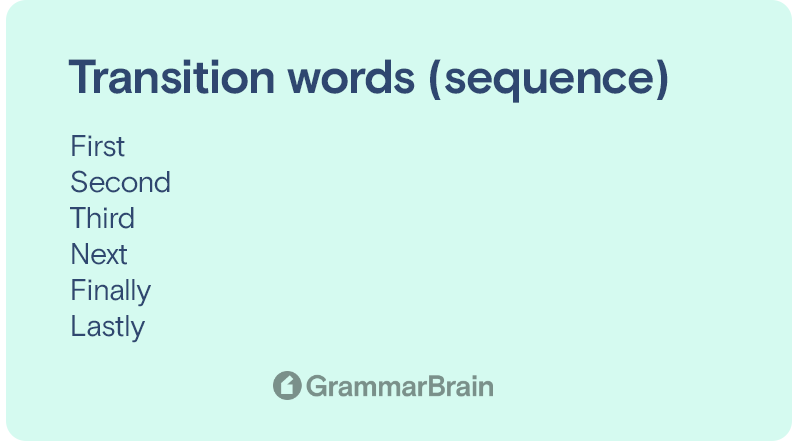
These transition words also define sequence or time. Here are some common sequence-based transition words that writers can include in their work:
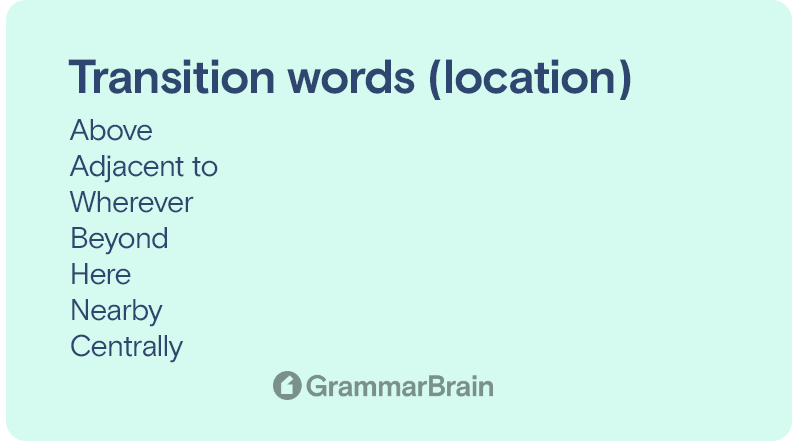
These transition words are used to connect things based on their location or where they are placed to each other. Here are some of them:

As the name suggests, emphasis transition words help you in stressing an important point and accentuate your argument. Here are some common emphasis transition words:
These transition words offer huge help when you are drafting the conclusion of your work. Whether you are working on a school essay, summing up an idea, or working on your blog, conclusion transition words are an integral part of all kinds of writing.
Here are some common conclusion transition words that writers can use to simplify their writing:
The main purpose of transition words is to make clunky, confusing, and disjointed sentences smooth, logical, and coherent. These words must be used to improve the flow of sentences and make your paper more engaging.
When trying to write in plain English, using appropriate transition words wherever possible can make a significant positive impact.
Writers must avoid making abrupt pauses or jumping from one sentence to another illogically. Instead, it is recommended to use transition words to establish an organizational flow in your work.
But the question is – do transition words actually work?
Let’s consider the following sentences – with and without the transition word – and see the difference:
While there is nothing wrong with these two sentences, they lack a logical flow. Here’s how using a transition word can improve it.
Again, while both of these sentences are grammatically correct, they neither sound good nor logical, There’s an abrupt pause between them. Let’s see how they’ll sound after adding a transition word.
Now, these two sentences don’t sound coherent at all. There is something off about them, they lack flow, and they don’t make any logical sense, right? However, once we add a simple transition word between them, they will become so much better. Here’s how:
By adding “or” (a contrast transition word), we linked the sentences. No need to rely on two awkward sentences that are better off as one.
In order to make a positive difference in your writing, the transition words must be used in a grammatically correct way.
When including transition words in their sentences, writers must remember the following important points:
1. The correct placement: When writing an essay, a blog, or an academic paper, the placement of the transition words plays a crucial role. Writers must plan where they want to place the transition words beforehand and then proceed with writing the sentences.
Generally, transition words can be placed –
2. Use a comma: When using a transition word in the middle of the sentence, it is important to always use a comma (,) before it. Doing so will separate the transition word from the rest of the sentence and give more clarity to your writing.
3. Consider the relationship between two sentences: It is another important tip that every writer must use while including transition words in their writing. Two sentences can have different kinds of relationships. They can be in agreement or disagreement with each other, there can be a cause-and-effect relationship, they can be in chronological order, etc.
Thus, it is crucial to have a clear idea about their relationship before deciding on a transition word.
In English, using transition words can do wonders for your writing. It can make it more appealing, logical, and clear for the readers. Today, we have learned a lot about transition words and how writers should use them in their work.
Here is a quick summary of everything that we have learned in this article:
The 10 most commonly used transitional words include the following:
When using transition words, it is important to strike the correct balance. Overusing transition words can make your work hard to read and reduce its quality.
While you can use multiple transition words in a paragraph, it is recommended to use just one transition word in a sentence.
3. What percentage of sentences should have transition words?With SEO becoming more and more important, using the right amount of transition words in your content has become all the more important. Following the best SEO practices and including the ideal amount of transition words in blogs and articles can help in increasing their Google ranking.
Ideally, a writer must ensure that at least 30% of their sentences include transition words. This will go a long way in improving the readability of their content and making it more engaging and simple.
4. How do you write an effective transition sentence?There are several ways to write effective transition sentences. Here are some writing tips that can help writers write effective transition sentences:
The five most common types of transitions include the following:
Inside this article

Fact checked:
Content is rigorously reviewed by a team of qualified and experienced fact checkers. Fact checkers review articles for factual accuracy, relevance, and timeliness. Learn more.

About the author
Dalia Y.: Dalia is an English Major and linguistics expert with an additional degree in Psychology. Dalia has featured articles on Forbes, Inc, Fast Company, Grammarly, and many more. She covers English, ESL, and all things grammar on GrammarBrain.